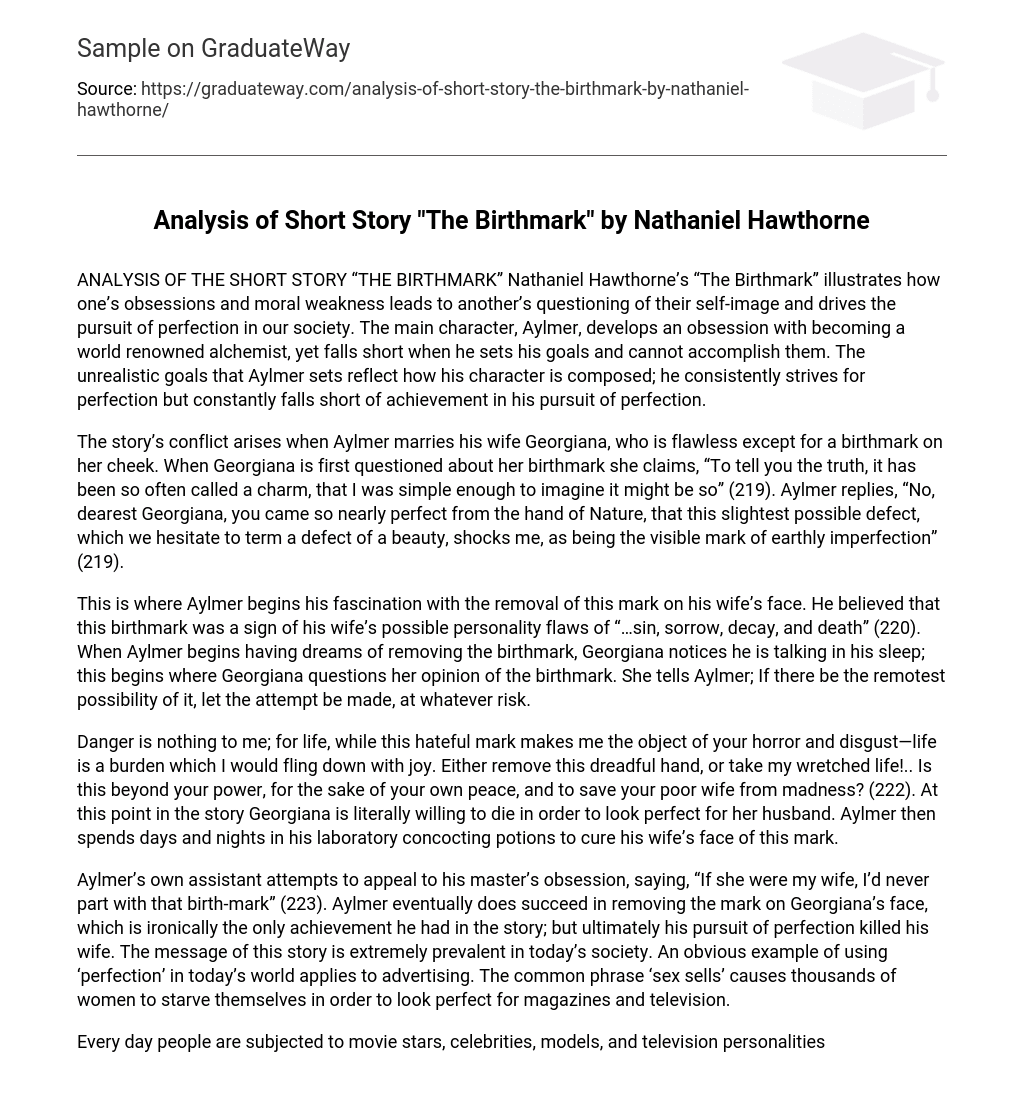Nathaniel Hawthorne’s “The Birthmark” illustrates how one’s obsessions and moral weakness leads to another’s questioning of their self-image and drives the pursuit of perfection in our society. The main character, Aylmer, develops an obsession with becoming a world renowned alchemist, yet falls short when he sets his goals and cannot accomplish them. The unrealistic goals that Aylmer sets reflect how his character is composed; he consistently strives for perfection but constantly falls short of achievement in his pursuit of perfection.
The story’s conflict arises when Aylmer marries his wife Georgiana, who is flawless except for a birthmark on her cheek. When Georgiana is first questioned about her birthmark she claims, “To tell you the truth, it has been so often called a charm, that I was simple enough to imagine it might be so” (219). Aylmer replies, “No, dearest Georgiana, you came so nearly perfect from the hand of Nature, that this slightest possible defect, which we hesitate to term a defect of a beauty, shocks me, as being the visible mark of earthly imperfection” (219).
This is where Aylmer begins his fascination with the removal of this mark on his wife’s face. He believed that this birthmark was a sign of his wife’s possible personality flaws of “…sin, sorrow, decay, and death” (220). When Aylmer begins having dreams of removing the birthmark, Georgiana notices he is talking in his sleep; this begins where Georgiana questions her opinion of the birthmark. She tells Aylmer; If there be the remotest possibility of it, let the attempt be made, at whatever risk.
Danger is nothing to me; for life, while this hateful mark makes me the object of your horror and disgust—life is a burden which I would fling down with joy. Either remove this dreadful hand, or take my wretched life!.. Is this beyond your power, for the sake of your own peace, and to save your poor wife from madness? (222). At this point in the story Georgiana is literally willing to die in order to look perfect for her husband. Aylmer then spends days and nights in his laboratory concocting potions to cure his wife’s face of this mark.
Aylmer’s own assistant attempts to appeal to his master’s obsession, saying, “If she were my wife, I’d never part with that birth-mark” (223). Aylmer eventually does succeed in removing the mark on Georgiana’s face, which is ironically the only achievement he had in the story; but ultimately his pursuit of perfection killed his wife. The message of this story is extremely prevalent in today’s society. An obvious example of using ‘perfection’ in today’s world applies to advertising. The common phrase ‘sex sells’ causes thousands of women to starve themselves in order to look perfect for magazines and television.
Every day people are subjected to movie stars, celebrities, models, and television personalities looking flawless every moment of every day. We look at these people as role models, but what many times happens is a person becomes obsessed with being flawless and actually makes themselves ‘perfect’ in an unhealthy way. This ‘perfection’ can also pertain to people wanting to get cosmetic surgery to tweak the flaws and imperfections they may see in themselves. The problem with this is people cannot be perfect, either physically or mentally. What one person sees as a vile disgusting birthmark may be another person’s beauty charm.
A problem with men and women in today’s society is they strive to be perfect for one another; when they try to correct a physical flaw they may create an internal flaw such as insecurity or self-consciousness. Hawthorne’s “The Birthmark” has a central theme of how one person’s pursuit of perfection can in the end backfire on themselves. Aylmer’s own internal defects were reproduced in his view of his wife’s physical imperfection. Georgiana was convinced that she and her husband would never be happy unless she could remove the only blemish on her face, and then they could live happily ever after.
When that backfired, Aylmer’s possession from the mark drove him to use his passion of the knowledge of science to remove the mark, which fatefully he used his love of science to kill his love for his wife. Hawthorne’s message to his readers should be that that people should realize that imperfection is perfect.
Works Cited
- Hawthorne, Nathaniel. “The Birthmark” The Norton Introduction of Literature. Ed. Alison Booth et. al. 10th ed. New York: WW. Norton and Company, 2011. 218-231. Print.





